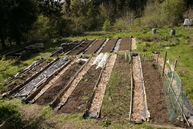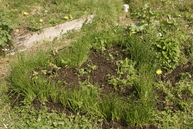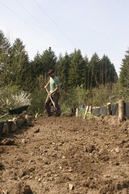The Growing Area… the story continues
This is the community’s original food growing space, initially chosen because there were very few trees within the space (although there are lots round the edge), thus avoiding tree clearance. It also has the advantages of being relatively flat and not too far from the entrance.
The main disadvantage of the space is its distance from our settlement area. Combined with wet, cold or hot weather and/or young children a trip to the growing area for any serious amount of work needs a certain level of preplanning as you (and your offspring, and possibly volunteers too) need waterproofs, drinking water, snacks, spare gloves, sunhats, and/or blankets. We have a tool storage shelter but no comfortable, totally weatherproof facilities as yet (actual growing always seems to take precedence over such luxurious infrastructure!).
It is still the most suitable place in the woods for growing annual vegetables, but has been low-yielding in the last few years for a few reasons and in 2008, following a shockingly poor year (a hot dry spring and cold, drenchingly wet summer: dead perennials, blighted potatoes and tomatoes and mouldy courgettes) we decided it was time for a rethink.
Following a few different experiments with mulching, we are now building a system of raised beds with mulched paths in between. It has been hard work but we expect it to raise yields enormously in the next few years as the soil settles and forms layers of humus. The raised walls make it easy to add bulk soil improvers (we’ve used our kitchen waste compost, comfrey leaves and local organic horse manure) without having to dig it in too much and disturb the substructure of the soil. The long thin shape of the beds makes them much more accessible for weeding. It makes them easy to cover when not in use, and cloches tend to fit the shape better too. Lastly, but importantly for a space where lots of different people including volunteers work, the beds seem to make planting and weeding seem simpler – you just start at one end and work towards another. It makes the growing on the scale we need less daunting.
The main crops we’ll be growing in 2009 are beans and peas; a mix of brassicas (concentrating on kale); potatoesand squashes, pumpkins and courgettes. One bed is full of native tree seedlings of local provenance to grow on.
Potential problems for this year: a full bed of bean seeds planted in early spring 2009 was eaten in its entirety by mice (except for one! I wonder, did it taste funny or were the mice full up?). The only way we can grow legumes and the squash family is to start them off in pots in the rodent-proof frame. And the distance from our dwellings is still an issue when growing quantities of high-maintenance crops.
Following permaculture principles, we should be planting more low-maintenance crops in this space, and we have indeed done so. Fruit trees were planted in 2001 and more recently in January 2009 along the top part of the growing area. We did not receive any grants for this, and it represents a significant investment, but we now have a magnificent orchard developing. We hope to become self-sufficient in fruit, particularly apples, as these trees crop to their full potential. Apples are important – some varieties ripen in July, others store through the winter into spring, so by careful selection of apple varieties you can have fruit from July until April the next year. We also planted plum, pear, and almond trees, a medlar and an apricot tree, and sea buckthorn and eleagnus bushes. All trees and bushes were sourced from the Agroforestry Research Trust in Dartington.
Author: Chris 2009
 Please Note: This website is out of date. The Steward Community Woodland sustainable living project ended
in 2018 for legal and planning permission reasons. The contents have been left here as a historical archive.
Please Note: This website is out of date. The Steward Community Woodland sustainable living project ended
in 2018 for legal and planning permission reasons. The contents have been left here as a historical archive.




